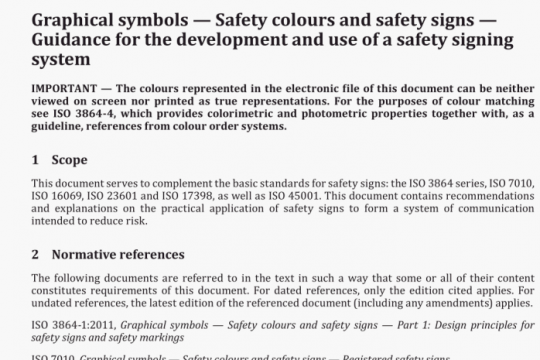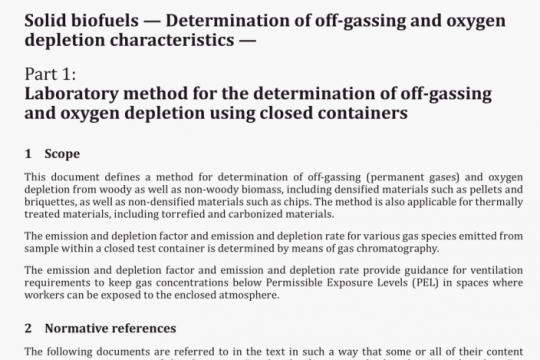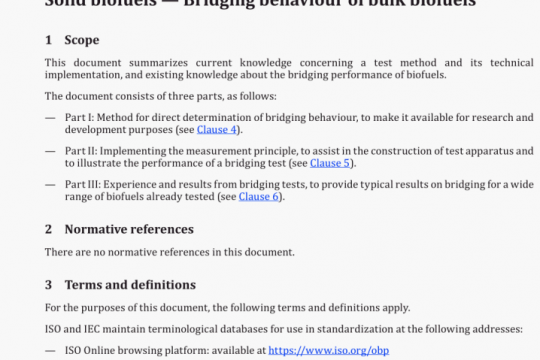ISO 21912 pdf free download
ISO 21912-2021 pdf free download.Solid recovered fuels一Safe handling and storage of solid recovered fuels.
The risk management process includes a risk analysis and a risk evaluation, which form the basis for the risk assessment and what risk reduction/control measures are required for each specific plant.
The objects, issues and aspects to be considered and documented in the risk management process are related to general design and construction and general operation and maintenance procedures including preplanning of emergency operations.
For fire prevention and fire protection of machinery, ISO 19353 should be used, when applicable.
Further specific issues to consider are also provided for receiving and feeding (8.1.1); crushing, milling and shredding (&Z); conveying (3); storage solutions (8A); separation and screening (&5); and other systems (4).
The documentation shall describe and justify the measures taken, as well as include aspects not considered applicable or relevant.
The person responsible for the risk management process shall have the necessary levels of competence to undertake a fire and explosion risk assessment; the level of competency required should be commensurate with the complexity of the facility to be assessed, i.e.:
a) A good understanding of SRF and the equipment and processes used for the production and along the supply chain of SRF
b) A good understanding of fire related aspects of building control and function
c) Appropriate knowledge of national fire/explosion and safety legislation and the requirements of other enforcing bodies and stakeholders (i.e. insurers)
d) Appropriately trained and/or experienced in fire/explosion safety and fire protection issues
e) Knowledge of relevant national and local codes and experience of application
5.2 Introduction to the risk management process
Management of risks include several steps and sub-steps as shown in Figure 2. In 5.2.1 to 5.2.5, the different parts of risk management are defined and described.
5.2.1 Definition of scope
When performing a risk analysis, the scope shall be defined, i.e. the system that is to be included in the analysis. This includes definition of the boundary of the system and to identify user, intended use and reasonably foreseeable misuse. Assumptions and limitations for the analysis should also be defined. Technical, environmental, organisational and other aspects relevant for the problem/system should be included.
5.2.2 Hazard identification
Hazard identification involves systematic review of the system under study to identify the type of inherent hazards that are present together with the ways in which they could be realized. Different hazards and sources of risks shall be identified and the type of hazard they pose analysed. Hazard identification methods fall mainly into three categories:
1) Comparative methods (e.g. checklists, hazard indices and reviews of historical data)
2) Fundamental methods, that are structured to stimulate a group of people to apply foresight in conjunction with their knowledge to the task of identifying hazards (e.g. HAZOP studies, Iso 12100 and FMEA)
3) Inductive reasoning techniques (e.g. event tree logic diagrams)
The significance of the sources of risks shall be analysed by an initial evaluation, based on a consequence analysis. The aim of this analysis is to decide whether:
a) Actions should be taken to eliminate or reduce the hazard
b) The analysis can be terminated due to the insignificance of hazard
c) The analysis should be continued with a risk estimation
There are many factors influencing the risk management, e.g. the storage capacity, annual SRF turnover and complexity of on-site handling and to consider all the variables that might be valid for a facility.
5.2.3 Risk estimation
Risk estimation should examine the initiating events or circumstances, the sequence of events that are of concern, any mitigating features and the nature and frequency of the possible deleterious consequences of the individual hazards to produce a measure of the level of the risk being analysed. The measures could address human, property or environmental risks and should include an indication of the uncertainty associated with the estimates. The risk estimation process can be described by the following steps:
a) Frequency analysis used to estimate the likelihood of each undesired event identified during the hazard identification stage. To estimate event frequencies three different approaches are commonly used: relevant historical data, analytical or simulation techniques and expert judgement
b) Consequence analysis is used to estimate the likely impacts should the undesired event occur.ISO 21912 pdf download.




